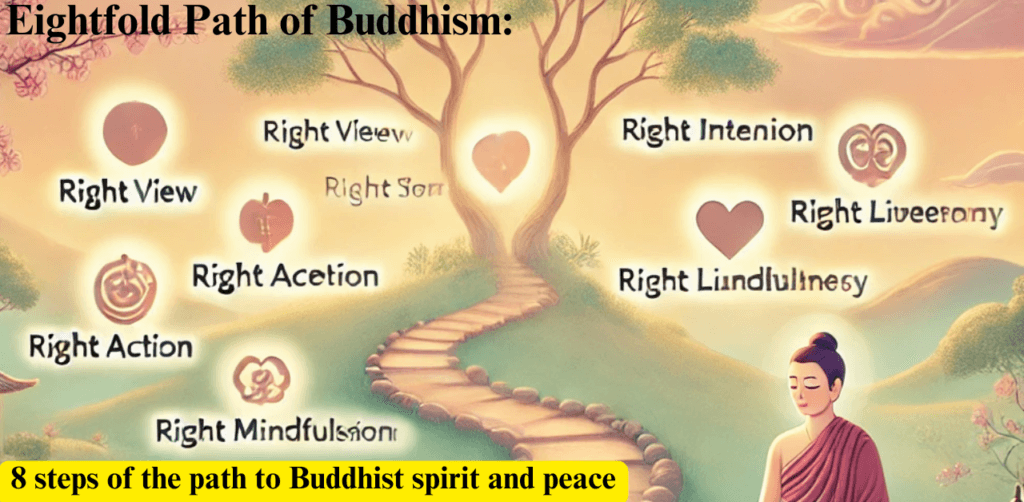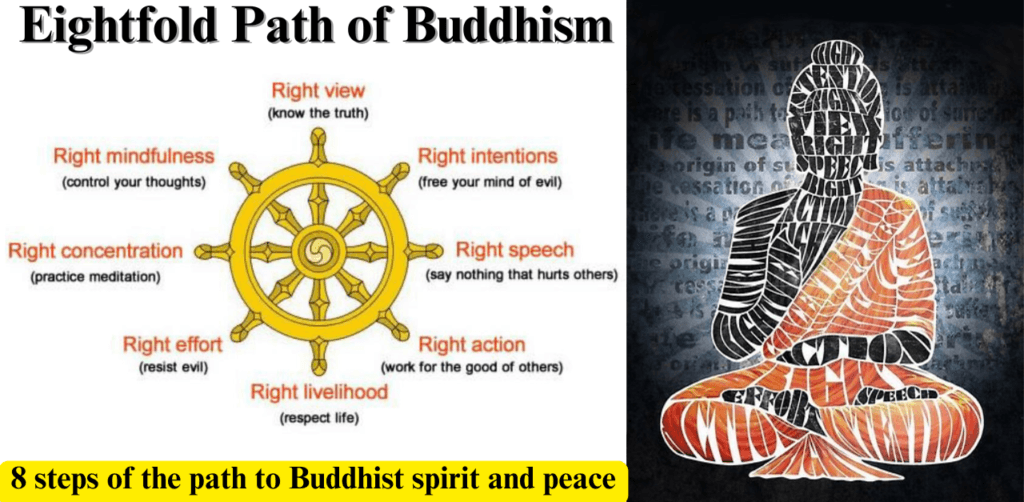
Table of Contents
Eightfold Path of Buddhism: 8 steps of the path to Buddhist spirit and peace

Eightfold Path of Buddhism
Eightfold Path of Buddhism : Founded by Siddhārtha Gautama (the Buddha) in the 5th century BCE, Buddhism is a philosophy and spiritual tradition that offers profound guidance on how to end suffering and achieve true peace. At the core of Buddhism is the Noble Eightfold Path, a guide to living a life free from suffering and achieving nirvana. This path consists of eight interrelated practices, each of which aims to transform the mind, behavior, and spirit. The Noble Eightfold Path represents Buddhist teachings on how to live an ethical, balanced, and enlightened life. It provides a practical guide to spiritual growth and the attainment of ultimate peace. Understanding the Noble Eightfold Path
The Noble Eightfold Path is divided into three main parts:
1.Ethical conduct (right speech, right action, right livelihood)
2.Mental discipline (right effort, right attention, right concentration)
3.Wisdom (right view, right intention)
These practices are not separate from one another but interconnected, with each reinforcing and supporting the other. As a holistic guide, the Eightfold Path aims to develop a life of ethical behavior, mental clarity, and wisdom that leads to the cessation of suffering and the attainment of nirvana.
The Noble Eightfold Path of Buddhism: 8 Steps of Buddhism’s Path to Soul and Peace
1.Right View
Right view is the understanding of the nature of reality. It involves seeing the world as it really is, understanding the impermanence of life, the nature of suffering (dukkha), and the interconnectedness of all things. In Buddhism, right view is fundamentally linked to an understanding of the Four Noble Truths:
1.The truth of suffering (dukkha)
2.The truth of the cause of suffering (samudaya)
3.The truth of the cessation of suffering (nirodha)
4.The truth of the path to the cessation of suffering (magga)
By developing right view, one begins to recognize the causes of one’s suffering and understand how to eradicate them, which is the essence of the Buddha’s teachings.
2.Right intention (samyak sankalpa)
Right intention refers to cultivating thoughts and intentions that are free from greed, hatred, and ignorance. It is about purifying the mind and focusing on actions that promote goodwill, kindness, and compassion. Right intention includes three key components:
1.The intention to abandon attachment
2.The intention to act in a compassionate way
3.The intention to develop harmlessness
By practicing right intention, individuals align their thoughts and actions with Buddhist virtues, reducing negative mental states and cultivating positive qualities such as kindness and compassion.
3.Right speech
Right speech focuses on ethical communication. It encourages speaking in a truthful, kind, and helpful way, avoiding harmful speech such as lying, gossiping, harsh words, and divisive speech. Right speech promotes harmony and understanding, and aims to create an atmosphere where people are treated with respect and honesty. The main principles of right speech include:
1.Speaking the truth
2.Speaking cordially and kindly
3.Avoiding harsh or divisive speech
4.Avoiding idle chatter and gossip
By following this practice, individuals contribute to an atmosphere of peace and mutual respect, thereby building trust and unity.
4.Right Action
Right action involves acting ethically and morally in all aspects of life. It emphasizes refraining from actions that harm oneself and others, such as killing, stealing, or behaving immorally. Right action encourages people to act with compassion, honesty, and mindfulness, thereby promoting peace and harmony. This practice is based on the five precepts of Buddhism:
1.Refraining from killing living beings
2.Refraining from stealing
3.Refraining from sexual misconduct
4.Refraining from lying or deceitful speech
5.Refraining from intoxicants or mind-affecting substances
Right action requires individuals to make choices that contribute to the well-being of oneself and others, leading to a life of moral purity.
5.Right Livelihood (Right Behavior)
Right livelihood involves earning a living in a way that does not harm or cause suffering to others. This principle encourages individuals to choose careers or occupations that are ethical and beneficial to society. Right livelihood emphasizes honesty and responsibility in all aspects of life, especially work and business. Buddhism discourages certain forms of livelihood that promote violence, exploitation, or dishonesty (e.g., arms trade, human trafficking, and fraud).
By practicing right livelihood, individuals ensure that their actions are consistent with their ethical values and contribute positively to society, both to their own well-being and to the well-being of others.
6.Right Effort
Right Effort involves developing a disciplined and focused approach to mental training. It is about making conscious efforts to prevent negative thoughts from arising and to develop positive mental qualities such as kindness, patience, and peace of mind. Right Effort encourages individuals to eliminate unhealthy states of mind and develop healthy states through sustained effort. It includes:
1.Preventing unhealthy thoughts from arising
2.Discarding unhealthy thoughts that have already arisen
3.Developing healthy thoughts
4.Maintaining healthy thoughts over time
Right Effort is a continual practice that helps individuals keep their minds focused on beneficial states, thereby supporting their overall spiritual development.
7.Right Mindfulness
Right Mindfulness
Right mindfulness means being fully aware and present in every moment. It involves developing clear and direct awareness of the body, emotions, thoughts, and events as they arise and cease. Through mindfulness, individuals can observe their internal states without becoming attached or reactive. This practice encourages non-judgmental awareness of one’s actions and thoughts, leading to a deeper understanding of the nature of suffering and its cessation. Right mindfulness includes:
1.Awareness of the body
2.Awareness of feelings and emotions
3.Awareness of the mind and mental states
4.Awareness of events as they arise
By practicing mindfulness, individuals gain insight into their behavior and mental patterns, which helps to break the cycle of suffering.
8.Right Concentration (Samyak Samadhi)
Right concentration involves developing deep states of meditation, where the mind is fully focused and free from distraction. Through meditation, individuals can achieve profound mental clarity and insight. Right concentration leads to states of absorption (jhana) where the mind is fully integrated and deeply connected with the nature of reality. It is through right concentration that individuals can directly experience the impermanent, unsatisfactory, and selfless nature of all things, leading to greater enlightenment and liberation. Right concentration involves:
Developing focus by practicing meditation
Achieving a state of deep mental clarity and peace
Developing insight into the true nature of reality
By developing right concentration, one develops a calm and focused mind that aids in the understanding of higher truths and the attainment of enlightenment.
The Interrelationship of the Eightfold Path
The Eightfold Path is not a series of steps to be followed in a linear progression. Rather, it is an integrated whole, where each element supports the other. Practicing right view leads to right intention, which leads to right speech, and so on. The practices of the Eightfold Path work together to help the practitioner transcend suffering and develop a deep understanding of the nature of existence.
The Noble Eightfold Path as a Path of Peace
The ultimate goal of the Noble Eightfold Path is to achieve Nirvana, the cessation of suffering. By following these eight practices, one can live a life of ethical conduct, mental clarity and wisdom, leading to inner peace and liberation from the cycle of birth, death and rebirth (samsara). The Eightfold Path provides a practical guide to living a life of balance, kindness and mindfulness – qualities that contribute to peace within oneself and in the world.

Conclusion:
The Transformative Power of the Noble Eightfold Path – A Journey Towards True Peace
The Noble Eightfold Path is not simply a set of ethical or moral guidelines; it is a profound spiritual journey that leads to the transformation of the mind, heart, and spirit. It provides a comprehensive framework for breaking free from the cycle of suffering, helping individuals to realize the ultimate truth of existence – that suffering is universal, its cause lies in our attachment and ignorance, and liberation lies in our ability to develop wisdom, ethical conduct, and mental discipline.
At the core of the Eightfold Path is the realization that inner peace and the cessation of suffering are not external pursuits, but are found within us. The path encourages us to look inward, develop a correct understanding of ourselves and the world, develop compassion, and take responsibility for our actions, speech, and thoughts. It is a call to live consciously, choosing kindness over hatred, truth over deceit, and wisdom over ignorance.
Each step of the Eightfold Path is not isolated; it is part of a larger whole. They are interconnected, leading us to balance and harmony in all aspects of life. Right view teaches us to perceive the world as it really is, not as we wish it to be. Right intention leads us to cultivate thoughts of kindness, compassion and the renunciation of selfish desires. Right speech, right action and right livelihood help us act in ways that promote peace, justice and well-being for all beings. Right effort, right mindfulness and right concentration lead us to mental clarity and insight, allowing us to make wise decisions and remain calm amid life’s challenges.
In a world where suffering, conflict and ignorance often prevail, the Eightfold Path stands as a beacon of hope and a reminder that true peace and happiness lie in the cultivation of inner wisdom, ethical conduct and mental discipline. It is a timeless guide that speaks to the heart of every human being, regardless of culture, background or belief.
Principles of the Eightfold Path
The principles of the Eightfold Path, rooted in compassion and wisdom, provide us with the tools to break free from the chains of suffering and live a life of true freedom and peace. This path is not easy, and it requires constant effort, patience, and mindfulness. But its rewards are enormous. As we gradually align our thoughts, speech, actions, and mental states with the principles of the Eightfold Path, we not only transform ourselves but also contribute to the creation of a more compassionate, harmonious, and peaceful world.
The Noble Eightfold Path reminds us that peace is not something that can be found in external conditions but something that we must cultivate from within. It is a call to rise above the ego, embrace compassion, and walk the path of wisdom with profound care and commitment.
The journey is long and challenging, but it is also the most rewarding journey anyone can make – a journey to the end of suffering, the cultivation of true wisdom, and the attainment of peace, not just for ourselves but for all beings. By following this path, we not only move towards personal enlightenment but also contribute to the well-being of humanity. Thus, the Noble Eightfold Path is not just a Teaching of Buddhism – it is a universal truth, a guiding light that can lead us to peace, harmony and ultimate liberation from suffering.
See Also This :
Nalanda University: From Ancient Glory to Modern Renaissance
https://networkbharat.com/nalanda-university/
https://networkbharat.com/surya-namaskar-10-miraculous-benefits/


